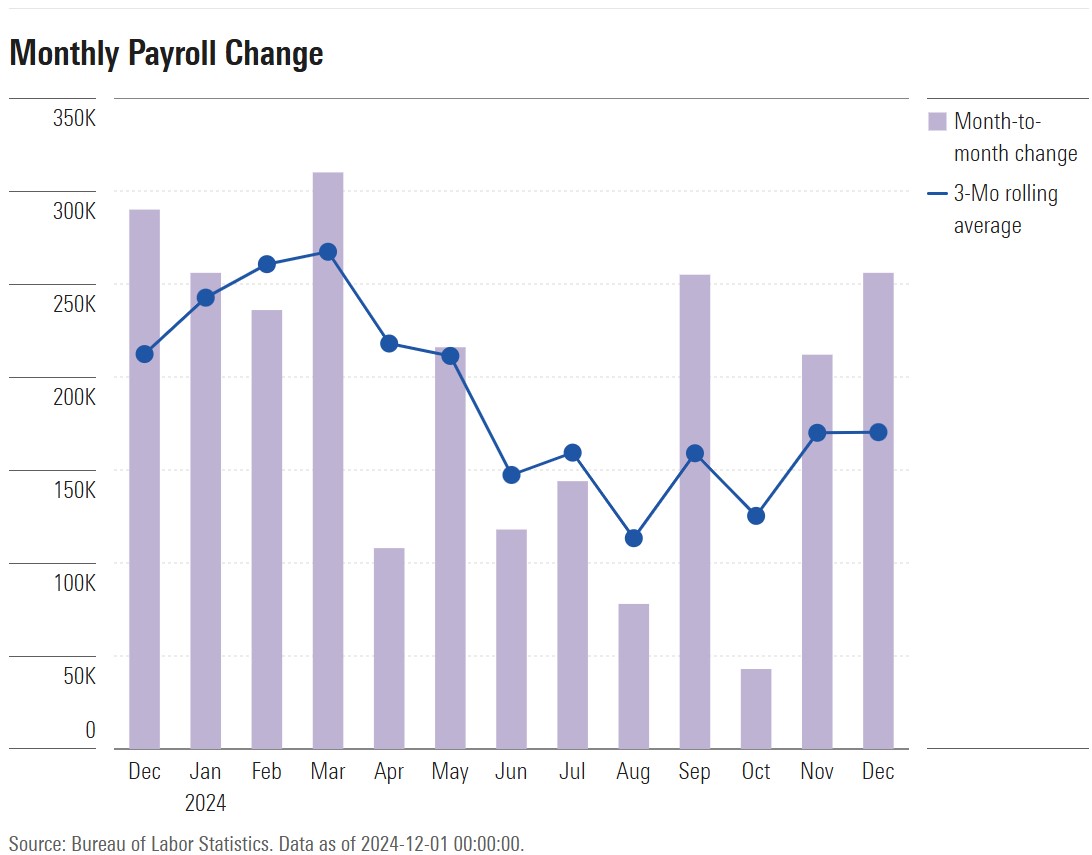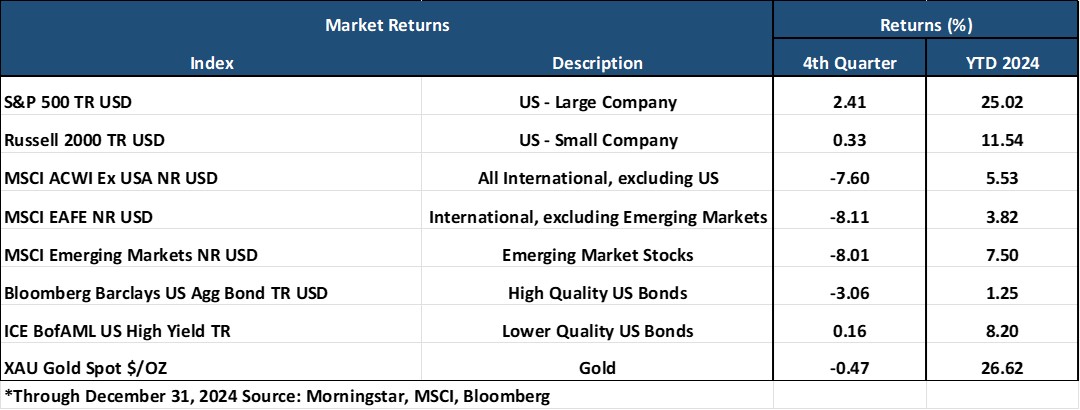Big Picture and Key Takeaway
4th Quarter 2024
(Click here for Printable PDF)
Key Takeaway
The global stock market rally decelerated in the 4th quarter after a particularly strong first 9 months of the year, despite the early optimism post-election about deregulation and tax cuts. While US Large-cap stocks moved modestly higher (S&P 500 +2.4%) and US Small-cap stocks posted a small positive return (R2000 +0.3%), developed international stocks (MSCI EAFE -8.1%) and emerging market stocks (MSCI EM -8%) both declined significantly due to a strong rally in the US dollar. The broad-based bond market also declined in the 4th quarter (AGG -3.1%) due to a steep increase in bond interest rates after the election, as the market anticipated the potential for higher deficits and stubborn inflation.
For the year, US Large-cap stocks and Gold were the biggest winners, up 25.0% and 26.6%, respectively, while developed international stocks and emerging market stocks both trailed, returning 3.8% and 7.5%, respectively. Once again, the performance of the S&P 500 was dominated by the “Magnificent 7” stocks (Apple, NVIDIA, Microsoft, Amazon, Tesla, Alphabet, and Meta), which contributed nearly 54% of the index’s return. Outside of the last two years, such extreme performance concentration has not been seen since 1998 and 1999 during the dot com era. As a comparison, the equal-weighted version of the S&P 500, which allocates to each company equally, returned 13% in 2024 – just over half the return of the market capitalization-weighted index.
While the US stock market experienced a notable increase post-election, culminating in a record high in the S&P 500 in early December, this enthusiasm waned as inflation proved more persistent than anticipated, thus forcing the Federal Reserve to adopt a more hawkish tone. At its December meeting, the Fed communicated a downward revision to its interest rate cut projection from four to two in 2025, while the futures market currently anticipates between one and two cuts for 2025.
As we move into 2025, the US economy remains on firm footing, further punctuated by strong recent employment and retail sales reports. As a result of the continued economic resilience, long-term bond interest rates have moved aggressively higher since November, pushing down bond prices. While a strong economy might seem optimistic for the overall financial market backdrop, any stickiness in inflation would likely pressure the Fed to cool off the economy by holding short-term interest rates “higher for longer” than expected. In addition, the uncertainty surrounding tariffs and their subsequent impact on inflation and economic growth has only recently added to market intrigue. Since early December, the wavering of the financial markets indicates a potential shift in the market psyche, away from the idea that monetary and fiscal support will be unabashedly positive forces in 2025 – and could instead be potential headwinds after a strong 2024.
While bonds have struggled in recent months, we feel that higher interest rates offer a silver lining and tailwind for potential outperformance in 2025. Meanwhile, even accounting for robust forward-earnings growth expectations for 2025, US Large-cap stocks remain expensively valued after two years of very strong returns as they reapproach all-time highs. The main questions for investors will be whether US Large-cap stocks are pricing in too much optimism relative to reality, whether a resilient US economy and earnings growth can continue to justify robust valuations, or will other less expensive asset classes, such as bonds, US small company or international stocks begin to outpace their US Large Cap stock brethren.
The Big Picture
Fourth quarter economic data remained strong as economic growth remained resilient and job creation continued apace. After some labor market softening in the late summer months, payroll growth has since rebounded, and the 3-month rolling payroll average (blue line) has ticked back up in recent months (see chart below). Still, inflation remains a concern given the relative economic strength and the unknown impact of the Trump administration’s proposed tariff and immigration policies on price pressures.
INFLATION: For December, the Bureau of Labor Statistics announced that the Consumer Price Index for All Urban Consumers (CPI-U) increased by 0.4% from November on a seasonally adjusted basis. Core inflation (all items less food and energy) rose by 0.2% month-over-month. The year-over-year rates were 2.9% (CPI-U) and 3.2% (Core), from 2.7% and 3.3%, respectively, in November. Gas costs were a primary driver of the higher-than-expected headline reading. In general, while the headline number (year-over-year) was higher than expected, the core results were slightly lower than expected – a modest relief after being stubborn in prior months. On a positive note, shelter costs, which make up more than one-third of the index's weight, showed continued signs of moderating.
GROWTH (Gross Domestic Product): Real gross domestic product increased at an annual rate of 3.1% in the third quarter, according to the "third" estimate released by the U.S. Bureau of Economic Analysis. In the second quarter, real GDP increased 3.0%. The update primarily reflected upward revisions to exports and consumer spending that were partly offset by a downward revision to private inventory investment. Looking ahead to the 4th quarter release, the Federal Reserve Bank of Atlanta's GDPNow forecasting model predicts an annualized growth rate of 2.7%.
JOBS: The December 2024 jobs report revealed a stronger-than-expected employment landscape, with nonfarm payroll employment rising by 256,000 jobs. The gains were led by hiring in the Education and Health, Retail and Leisure and Hospitality sectors. For the full year of 2024, the labor market added 2.2 million jobs. The unemployment rate also declined to 4.1% from 4.2% in November. The latest employment report was accompanied by continued wage growth, as wages increased by 3.9% year-over-year. Despite moderating slightly from a pace above 4%, the wage growth metric remains high relative to the overall inflation rate and is closely monitored by the Federal Reserve as a source of future inflationary pressure.
EARNINGS and ESTIMATES: As of January 10th, research firm FactSet reported that for Q4 2024, the estimated (year-over-year) earnings growth rate for the S&P 500 was projected to be 11.7%, which would mark the highest (year-over-year) growth rate reported by the index since Q4 2021 (31.4%). The estimated (year-over-year) earnings growth rate for the entire year of 2025 is 14.8%, which is above the trailing 10-year annual average earnings growth rate of 8.0% (2014 – 2023). According to FactSet, analysts also believe earnings growth for companies outside the “Magnificent 7” will improve significantly in 2025. While analysts expect the “Magnificent 7” companies to report earnings growth of 21% in 2025, they expect the other 493 companies to report earnings growth of 13% for 2025 - a substantial improvement to analyst expectations of just over 4% earnings growth for these companies for 2024.
RATES AND THE FED: In December, the Federal Reserve reduced the federal funds rate by 25 basis points, setting the new target range at 4.25% to 4.5%. This marked the third consecutive rate cut, totaling a full percentage point reduction since September, as the Fed aimed to balance economic growth with inflation control. Fed Chair Jerome Powell indicated a more cautious approach for 2025, suggesting fewer rate cuts than previously anticipated. He stated, "We are at or near a point at which it will be appropriate to slow the pace of further adjustments," and emphasized the need to "see more progress in lowering inflation" before making additional cuts. These comments suggest that the Fed is likely to implement only two rate cuts in 2025, compared to the four cuts projected earlier.
Market Performance
Global Stocks
For the 4th quarter, 26 of the 36 developed markets tracked by MSCI were negative. And of the 40 developing markets tracked by MSCI, 38 were also negative.
In the U.S., large companies outperformed small companies for the quarter, and growth stocks beat value stocks.
Only 4 of the 11 S&P 500 sectors delivered a positive return.
The Consumer Discretionary sector performed best for the quarter, followed by Communications Services, Financials, and Information Technology.
The Materials and Healthcare sectors each posted double-digit negative returns.
Developed and emerging market international stocks posted losses in the fourth quarter. The underperformance was attributable to a sharp increase in the U.S. dollar after the election – a headwind for international stock performance.
Due to political instability, Korea was the major market loser for the quarter, while China, India and the Philippines also struggled mightily to close the year.
Bonds
The bond market posted a negative return for the quarter as bond interest rates increased significantly. The highlights include the following:
The 10-year Treasury bond yield increased by 0.78% for the quarter, leading to a decline in U.S. Treasuries as the market priced in fewer than expected Fed rate cuts to start the quarter.
Treasury Inflation-Protected Securities declined but outperformed standard Treasuries as inflation expectations increased along with more stubborn inflation data.
U.S. mortgage-backed securities declined in line with Treasury bonds as their maturity profiles extended along with increased interest rates, leading to less potential future refinancing activity.
Credit spreads, a measure of the bond market's default risk, declined slightly for the quarter. The highest credit quality bonds underperformed relative to lower credit quality bonds, the latter of which have higher income payments due to their inferior credit quality.
The Municipal market outperformed its taxable bond market counterparts as yields on municipal bonds increased less than equivalent maturity Treasury Bonds.
Important Disclosure Information
This report is provided as information and commentary regarding the market. The views expressed in this report are as of the date of the report, and are subject to change based on market and other conditions. This report contains certain statements that may be deemed forward-looking statements. Please note that any such statements are not guarantees of any future performance and actual results or developments may differ materially from those projected.
Please note that nothing in this report post should be construed as an offer to sell or the solicitation of an offer to purchase an interest in any security or separate account. Nothing is intended to be, and you should not consider anything to be, investment, accounting, tax or legal advice. If you would like investment, accounting, tax or legal advice, you should consult with your own financial advisors, accountants, or attorneys regarding your individual circumstances and needs. Advice may only be provided by AtwoB after entering into an investment advisory or financial planning agreement. Moreover, you should not assume that any discussion or information contained in this newsletter serves as the receipt of, or as a substitute for, personalized investment and/or planning advice from AtwoB. If you are an AtwoB client, please remember to contact AtwoB, in writing, if there are any changes in your personal/financial situation or investment objectives for the purpose of reviewing/evaluating/revising our previous recommendations and/or services.
Past performance is not a guarantee of future returns. Investing involves risk and possible loss of principal capital. Different types of investments involve varying degrees of risk, and there can be no assurance that the future performance of any specific investment, investment strategy, or product (including the investments and/or investment strategies recommended or undertaken by AtwoB, or any non-investment related content, made reference to directly or indirectly in this newsletter will be profitable, equal any corresponding indicated historical performance level(s), be suitable for your portfolio or individual situation, or prove successful. Historical performance results for investment indices and/or categories have been provided for general comparison purposes only, and generally do not reflect the deduction of any fees or expenses, transaction and/or custodial charges, the deduction of an investment management fee, nor the impact of taxes, the incurrence of which would have the effect of decreasing historical performance results. It should not be assumed that your account holdings correspond directly to any comparative indices and/or categories.
AtwoB is neither a law firm nor a certified public accounting firm and no portion of the newsletter content should be construed as legal or accounting advice. A copy of the AtwoB's current written disclosure Brochure discussing our advisory services and fees continues to remain available upon request.
Index and Category Definitions
The S&P 500 Index is a capitalization-weighted index of 500 U.S. stocks. Russell 2000 TR USD is a market cap weighted index The Russell 2000 measuring the performance of approximately 2,000 smallest-cap American companies The MSCI All Country World ex-USA Index is a free float-adjusted market capitalization weighted index that is designed to measure the equity market performance of developed and emerging markets. The MSCI All Country World ex-USA Index consists of 22 developed and 24 emerging market country indices. The MSCI EAFE Index (Europe, Australasia, Far East) is a free float-adjusted market capitalization index that is designed to measure the equity market performance of developed markets, excluding the U.S. & Canada. The MSCI Emerging Markets (E.M.) Index is a free float-adjusted market capitalization index that is designed to measure equity market performance of 24 emerging markets countries. Bloomberg Barclays U.S. Aggregate Bond Index is an index of the U.S. investment-grade fixed-rate bond market, including both government and corporate bonds. ICE BofAML U.S. High Yield Index is an unmanaged index of below-investment grade U.S. corporate bonds. XZU Gold Spot $/Oz reflects the exchange rate of Gold against the U.S. dollar index.



